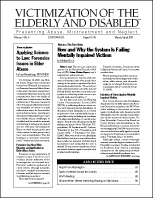Worth Reading and Watching
Author: Robert A. Mead, J. D., M. L. S..
Source: Volume 12, Number 05, January/February 2010 , pp.71-74(4)

< previous article |next article > |return to table of contents
Abstract:
In 1988, the federal Department of Housing and Urban Development created the Home Equity Conversion Mortgage (HECM) program, also known as reverse mortgages. Unlike a traditional mortgage, in which equity accumulates as the loan is paid off, reverse mortgages allow a homeowner to borrow money against the equity in the home, essentially reversing the process of a traditional mortgage. Reverse mortgages are only available to persons at least 62 years-of-age. They often have been extolled by the elder advocacy community as good products for elders who are in dire financial situations, because they allow an elder to stay in her home but still access part of the equity in the home. Under a reverse mortgage, a senior may stay in her home until she passes away, moves away for more than a year, or sells the house. Unfortunately, the real estate bubble affected the reverse mortgage program as well, and fraudulent and abusive practices began to appear within this industry. The following reports and audio files provide a fair summary of the risks associated with reverse mortgages. It is important to note, however, that reverse mortgages remain important tools of last resort for elders who need assistance: “Reverse Mortgages: Leaving Seniors and Taxpayers on the Hook?”, United States Senate, Special Committee on Aging, Jun. 29, 2009, and “Subprime Revisited: How Reverse Mortgage Lenders Put Older Homeowners’ Equity at Risk”, by Tara Twomey and Rick Jurgens, Oct. 2009Keywords: reverse mortgages
Affiliations:
1: New Mexico Supreme Court.